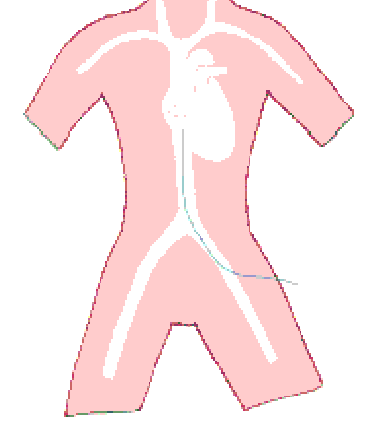
| Cardiac Catheterisation Test |
|
|
Down's Heart Group P.O. Box 4260 Dunstable, Beds, LU6 2ZT, United Kingdom Tel. & Fax: 0845 166 8061 E-mail: info@dhg.org.uk On-line community: http://groups.yahoo.com/group/Downs-Heart/ |
Reprinted with the permission of Penny Green, Director © 1998 Down's Heart Group UK Charity Nº 1011413 |

Diagram shows the heart looking from the front of the patient
How it is done
The catheter, which is a fine tube, is inserted through a special needle or small incision through the skin of the groin, and into a vein or artery. The Cardiologist then gently manipulates the catheter and guides it along with the blood flow into the various chambers of the heart, using low dose x-ray screening to monitor its progress. The pressures within each chamber and in the arteries can then be measured and small blood samples taken to check the oxygen levels in the different parts of the heart. They will also perform an angiogram where they use a special liquid which they inject through the catheter, to show the details of the heart chambers and blood vessels, and these images are recorded on x-ray and video for the cardiac team to review at a later date. when they discuss your child's defect and plan treatment. The test is carried out either using a local anaesthetic whilst your child is sedated, or else under general anaesthetic, and your child will not feel any discomfort or pain.
Preparation
Your child will not be allowed to eat or drink for about four hours before their Catheter Test, so if you have a young baby it may mean altering their feeding pattern to fit in with this. Generally children are given a pre-med on the ward, though small babies are often not given it. It is usually a sticky liquid given by mouth in a syringe, which will tend to make your child sleepy.
Your child may also be given a patch with some "magic cream" on the back of each hand. This is called Emla Cream, which reduces pain or discomfort when inserting a needle or cannula by numbing the skin.
The Test
Most units will let you go with your child to the catheter unit, and stay until the anaesthetist has put them to sleep if they are having a general anaesthetic. To do this he will use either a mask, or a needle inserted into your child's hand.
The time taken for the test varies from about one to three hours depending on the type of defect your child has, but you will usually be given an estimate of the time that your child is likely to be in the catheter unit
After the Test
Once the Cardiologist has obtained all the information and blood samples he requires, he will remove the catheter and pressure is applied to the small hole in the groin until the bleeding stops. Your child will then be woken up and taken back to the ward. They may feel sleepy or restless for the next few hours, or perhaps even feel sick from the effects of the anaesthetic.
The nursing staff on the ward will carry out regular checks on your child including taking their temperature and checking the wound in their groin. Sips of clear fluids will be allowed initially and if your child is not sick, these will be increased. Milk and other drinks will be given later.
The cardiologist who performed the catheterisation will usually come and speak to you on the same day and discuss his initial findings, although he may not have the full detailed results immediately. He will want to take a closer look at the films and make calculations before explaining fully, which he may do either before your child is discharged or at a later outpatient appointment.
Going Home
Provided your child is well they will be allowed to go home the day after the test, but the groin area should be kept clean and dry whilst the wound is healing, and it is advisable for them not to go into water or have a bath for five days after catheterisation to prevent infection of the wound.
Although this is a complex test, in the vast majority of children it can be performed safely without any problems.
| Revised: December 19, 2005. |